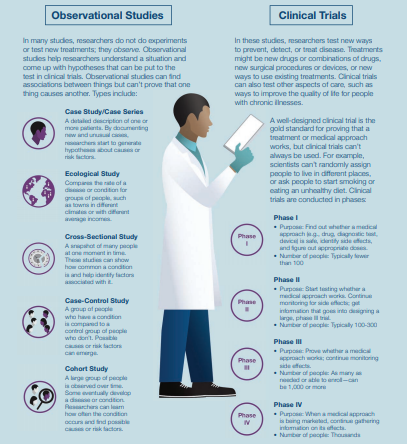

Things to consider
This section focuses on the items to consider prior to starting to develop your protocol. We assume that you already have a research question or hypothesis you plan to test.
|
Prior to developing your protocol you must consider which regulations and guidelines you need to follow. To ascertain this you will need to:
The same regulations may not apply to a very simple, minimal risk clinical trial or study compared to a higher risk Clinical Trial of an Investigational Medicinal Product (CTIMP). |
WHO definition of a clinical trial:'a clinical trial is any research study that prospectively assigns human participants or groups of humans to one or more health-related interventions to evaluate the effects on health outcomes. Interventions include but are not restricted to drugs, cells and other biological products, surgical procedures, radiological procedures, devices, behavioural treatments, process-of-care changes, preventive care, etc.' [WHO] Consider what your research involves? Anything which requires a change to standard clinical care practice and additional data collection becomes research and therefore requires the development of a protocol. Regulation and guidelinesClinical trial regulations can be confusing, over recent years there has been a huge increase in regulations applicable to clinical trials. The links below will assist you with identifying those which apply to your research. Also, consult your (planned) funder and local research authorities for guidance. |
|
Click here to access NIAID ClinRegs - an online database of country-specific clinical research regulatory information designed to assist in planning and implementing international clinical research. Click here for a brief overview of clinical trial regulation with links and notes from The Global Health Network. Click here to access the International Ethical Guidelines for Biomedical Research Involving Human Subjects. |
|
|
|
The SPIRIT 2013 Statement provides evidence-based recommendations for the minimum content of a clinical trial protocol. The recommendations are outlined in a 33-item checklist and figure. Important details for each checklist item can be found in the Explanation & Elaboration paper. |
ICH Good Clinical Practice (GCP)
If you are conducting a clinical trial then you need to follow the principles of ICH-GCP. The intention of ICH-GCP is that these principles are adapted to be appropriate for the risk and complexity of your trials – and so it is not necessary to apply ICH—GCP to the letter across your whole trial. The intention is you apply what is relevant and appropriate to assure the quality, safety, and ethical conduct of your trials.
There is no legal requirement for other types of research to be conducted in accordance with GCP but the basic principles set out to ensure the data is valid, that the question can be answered by following a robust and appropriate protocol and that the study was conducted ethically and safely. Sound principles for all types of clinical research.
|
You can take an eLearning course in Good Clinical Practice, available in several languages here. Access the WHO Guidelines for Good Clinical practice here. |
A note on ICH Good Clinical Practice (GCP)ICH-GCP draws on the basic principles of the Declaration of Helsinki which states that all research involving human subjects needs to collect reliable and accurate data and protect the rights and the safety of the participants. These principles are of course highly desirable and so surely should be applied to all health related research? However, ICH-GCP guidelines were written for drug and vaccine product development trials and therefore are very difficult to adapt to other forms of clinical trials with different interventions, and non-interventional studies; yet these studies also need to be safe, ethical and accurate. This makes a case for moving away from ICH-GCP and devising new guidelines that assure quality, safety and ethical standards for all studies and be easy to adapt and apply relative to the risk and complexity of the design and context. Appropriate new guidelines such as this would remove the need to differentiate between types of research and thereby remove the barriers to integrated research - so leading to faster and better progress. Surely it is time to do this? |


